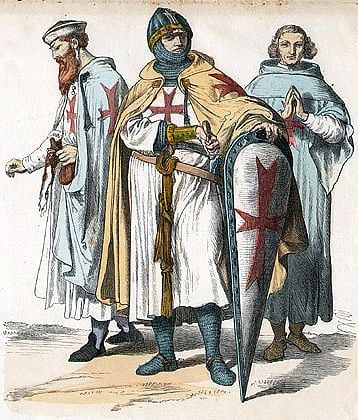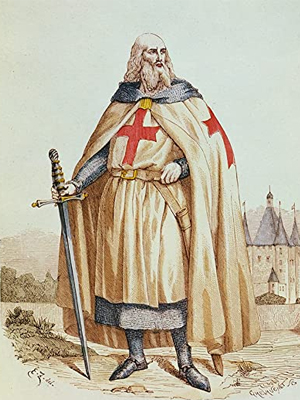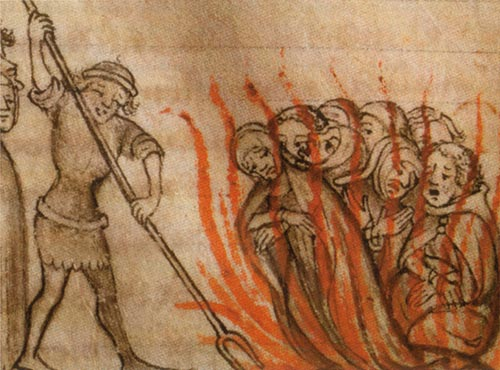Who Were the Knights Templar?

Photo source: https://www.worldhistory.org/Knights_Templar/
January 25, 2023
One of the most famous Christian military orders that participated in the Crusades, their portrayals have become synonymous with a crusading knight in the holy land, but what is the origins and story of this order of holy warriors?
Name: The Knights Templar was officially known as the Poor Fellow-Soldiers of Christ and of the Temple of Solomon.

Origin: They were founded in 1119, with their headquarters on the Temple Mount in Jerusalem (hence the name Knights Templar). Their main mission was to fight heathens in the holy land (the Levant) and protect pilgrims. Most of their order was based on this mission, 90% of the order was made up of non-combatant members who mainly engaged in Christian finance, they were meant to assist and fund the Knights of the order who would fight on the front lines.
Organization: The Knights Templar numbered between 15,000 and 20,000 at its peak. Their organization was one that could be mainly looked at in its financial form and its armed form. The Knights Templar were led by a Grandmaster.
On the financial side, they were pioneers of Christian finance and early banking. They developed innovative financial techniques and received a lot of their initial funds from donations but went on to control large swaths of land known as commanderies. They soon became a major financial institution in the medieval world as nobles would use their large infrastructure to place their money in for safeguarding. Since lending money and charging interest (usury) was sinful, the order would lend out land (claiming that they had a right to the mortgaged property’s production) and charge rent on it, that way they could avoid claims of usury. The order needed all this land in infrastructure to fund its knights, as arming a knight was an extremely expensive undertaking (in 1180 about 1.9 miles² of an estate would be required to fund a knight, and in 1260 10 square miles).
The other part of the Knights Templar were the armed component. These were notably the knights who undertook religious vows, like poverty, chastity, and obedience. The knights were heavy cavalry who dedicated themselves to protecting the holy land. These warriors wore white mantles with the red cross on them. Another component of the armed branch were the sergeants. Before joining the order, they came from various non-noble backgrounds, meaning they would have valuable skills like blacksmithery and building. They would fight alongside the knights as light cavalry, and they wore black or brown. There were also chaplains, who were ordained priests who had joined the order and provided the spiritual needs of their fellow members. These chaplains also wore the red cross of the Templars.

The Templars were known for their strict rules that members of the order had to follow (several hundred clauses), the original of these being the “Latin Rule.” It had 72 clauses that its knights had to follow. Some of these rules included: A specific dress code, number of horses they could own, and forbid them from speaking during meals, eating meat more than three times a week, and having any physical contact with women, even if they were family members. Although not a rule, many of its members grew beards, and these became synonymous with them. Another rule the Templar’s knights had to follow was a pledge to never surrender in combat unless their flag had fallen (and they could not regroup with another holy order), or if they were outnumbered three to one and their commander ordered them to surrender.
The order’s unwillingness to surrender, exceptional training and heavy armament made them a renowned force and a major obstacle to Muslim forces in the holy land.

Fall: With the fall of the holy land to the Muslims (and the Knights’ failure to prevent it), the Knights Templar’s purpose was beginning to be called into question. Their influence in Europe was also too much for European rulers to ignore, not to mention the fact that these rulers were also highly indebted to the order. This meant that they had made many enemies, including the King Philip IV of France, who owed them large sums of money. He used the waning support of the Templars and rumors of their heresy to convince the French Pope Clement V to condemn them, and supported his dissolution of their order and the confiscation of their lands.
Among the things the Templars were accused of: Heresy, homosexuality, financial corruption, devil-worshiping, fraud, spitting on the cross, and numerous other claims.
Many of the Knights Templar were burned at the stake, including their last grandmaster Jacques de Molay in 1307. Their organization was also dissolved in numerous other countries afterwards.

Timeline and story:
- -1119- The Knights Templar was founded in Jerusalem by Hugues de Payens and Saint Bernard of Clairvaux (First Grandmaster), along with 8 other knights.
- -1129- The Knights Templar achieves official recognition from Pope Honorius II as a military order.
- -1147- The Knights’ first engagement during the Second Crusade.
- -1177- Battle of Montgisard, where the Knights helped the Kingdom of Jerusalem crush Saladin’s army and save Jerusalem.
- -1187- The Knights Templar and other Levant Crusader states’ forces are beaten by Saladin’s army, which would lead to the fall of Jerusalem to the Ayyubids.
- -1189- Third Crusade. The Templars played a major role in the Third Crusade and regained some territory in the Levant.
- -1291- Siege of Acre, fall of the Kingdom of Jerusalem and headquarters of the Templar to the Mamluk Sultanate, leading to the Templars headquarters moving to Cyprus.
- -1306- The Templars helped Amalric, Lord of Tyre, overthrow Henry II of Cyprus, but Henry II later came back to power with the help of the Hospitallers, and eventually he would oversee the Templars’ dissolution in Cyprus in 1313.
- -1307- On Friday the 13th of October, French King Philip IV ordered the arrests of the Templars in France for heresy, and confiscated their assets.
- -1312- The Templars were suppressed by Clement V in his Papal bull “Vox in excelso”
- -1314- Jacques de Molay, the last grandmaster of the Knights Templar, is burned at the stake.
